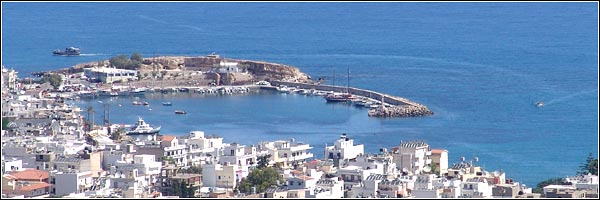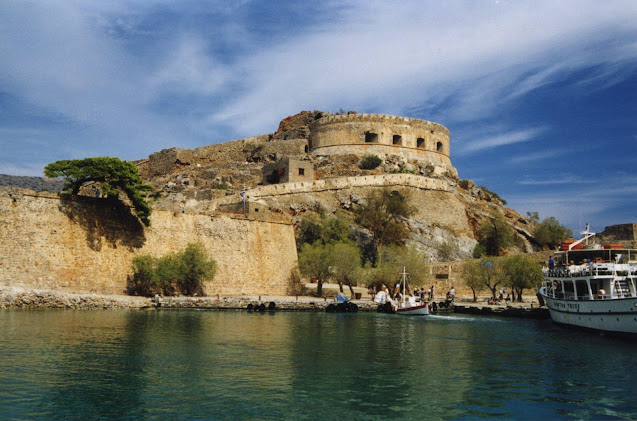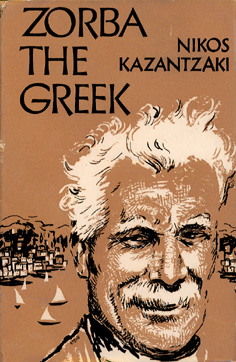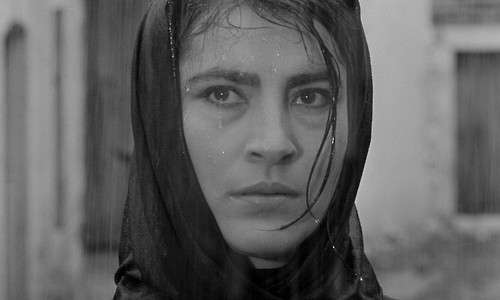THE BIRTHPLACE OF THE OLYMPIC SPIRIT
Zeus was born on Crete, and was given birth in Ideon Andron a deep dark cave, which lies on the highest mountain of Crete, Psiloritis (meaning Highest Peak).According the tradition, Rhea, the spouse of the almighty Cronus who was then the sovereign God, had looked for a shelter, in order to give birth to her son secretly; that was because Cronus had devoured all the other children she had given birth to, since he was afraid that his offspring would later dethrone him.
When the Cretan Zeus came to this world and his first weeping was heard, there was a risk of his father to discover his existence. Therefore, Rhea provided for it, by rendering Zeus's tears that soaked the soil into young warrior-gods called Kourites, who are considered as the first inhabitants of Crete. The help offered to the holy infant by Kourites was that, each time he would start crying, they stood outside the cave dancing their fierce, was dance, clapping their swords against their iron shields, in order to muffle the crying sounds. That was done to protect him from his ill-disposed father.
Some years later, when the grown-up Zeus was recognized as the unquestionable God of men - after winning the war against his father - the good gods Kourites, who had meanwhile taught people how to lead a peaceful life in organized societies and had initiated them into the secrets of dance and song left for the holy land of Ancient Olympia. The older of them who was called Hercules - just like the one who is referred to as demigod in mythology with his famous labours - came up with the idea to tell his brothers to run into the beautiful plains, in order to see who would be the winner. Peoneos,who was fast like the wind, came first and was crowned with wild olive-tree twigs by his brother Hercules.
Thus, the myth wants the Olympic spirit to be born in ancient Olympia by Cretan gods ; later on, this became the symbol of noble emulation between the nations in the field of sports and promoted peace among them.
Here, the visitor can admire the remnants of brilliant civilizations, explore glorious beaches, impressive mountain scapes, fertile valleys, and become part of the island’s rich gastronomic culture. Crete is, after all, a small universe teeming with beauties and treasures that you will probably need a lifetime to uncover!
WELCOME TO CHANIA
The town of Chania lies in the western part of the island,155 kilometers away from Heraklion and is considered one of the most beautiful towns in Greece. The heart of town beats on the Venetian part. A great part of the town's center is taken up by the old town, wich is one of the most picturesque places in Chania, with the buildings preserved from the Venetian and Roman years. The old town's point of reference is its stone paved Santrivani Square.
The citadel of ancient Kydonia was built on the neighbouring hill. The bastion Kastelli, the only remnant of the Arab domination, around which some parts of the wall from various periods are preserved, surrounds the hill. Splazia,an old Turkish quarter with many pedestrian zones, picuresque narrow streets and well-preserved buildings lies in the eastern part town. There lies also the church of Agios Nikolaos, which was converted into a mosque by the Turks.
The town is situated very close to the port of Souda. Its numerous, lovely beaches lie in the west.
The "municipal beach" is very close to town, when you take the street behind the Marine Museum, which is lodged by a well-preserved part of the castle, at the Venetian port.
Besides, a remarkable Archeological Museum lodged in an exquisite Franciscan convent that was built in the beginning of the 16th century stays at the visitors' disposal. Finally, there is also and important Historical Museum, which is lodged in one of the town's elegant, neoclassical edifices.
CHANIA
WELCOME TO HERAKLION
The town of Heraklion lies at a short distance from the worldwide famous ancient Knossos. This is a town with a rich cultural past, age long history and rapid developement. It is the largest town on Crete. Nowadays, it disposes a modern, well-organized port that was the most important one in the Eastern Mediterranean during the times of Venetian dominion.
Going up from the port and heading for the historical center of Heraklion, the 25th Avgoustou street - which was known as the cosmopolitan Ruga maistra in the times of Venetian dominion -take us to the center of the town, on Eleftheriou Venezelou Squere. This is also popular as Liontaria (Lions Squaare) among the inhabitants, due to the famous fountain of the four stone lions Morosini lying on the square.
The Temple of Saint Markus lies right opposite. Nowadays this has been rendered into an exposition and conference hall. A little further, at the beginning of 25th Avgoustou street, there is Loggia, which used to be the Club of the noble Venetians. Nowadays, Loggia is the Town Hall.
Behind the Town Hall, one can see the exquisite church of Saint Titos, situated on a beautiful, stone-paved square. From the architectural point of view, Saint Titos is much more interesting than the town's cathedral, Saint Minas, which also lies in the center.
From the beautiful lion square, right opposite the fountain Morosini, the most important pedestrian zone, which is the commercial Dedalou Street. Dedalou ends on Eleftherias Square that is also popular as Tris Kamares. At the edge of that square there is the extremely important Archeological Museum of Heraklion, built on the location where there was the catholic church of Saint Fragiscus, the majestic ecclesiastical edifice of the Venetians, which colapsed, abandoned by the Turkish conquerors.
In the North of Liontaria Square lies the Park Domenicus Theotokopoulos. From there, Minotavrou Street takes us to the very important Historical and Ethnological Museum of Heraklion. The very important municipal lecture hall and spiritual center, Vikelea,which used to be the library of the Greek Nobel prize winner, the poet George Seferis, lies right on Lion's Square.
One of the most impressive monuments in town is the Venetian wall. On their southwestern bastion (Martinengo bastion) lies the simple, unadorned grave of the great worldwide famous Cretan author and philosopher, Nikos Kasantzakis.
WELCOME TO HERSONISSOS
Hersonissos, is a beautiful romantic town 25 kilometers east of the city of Heraklion. Hersonissos offers not only physical relaxation and mental jubilation but also and atmosphere of euphoria.
A precious stone on the coast of the foaming blue Cretan sea, this town becomes a challenge for your memory with every step you take, fortunate visitor. Luxurious hotels, interspersed throughout the area await to welcome you and offer you the traditional hospitality.
Modern tourist shops, envied for the welth, are ready to serve you by satisfying even your most though demands.
Taverns, Pubs, Bars, Discos and many other contemporary night clubs whose aim is to please and amuse, are at your disposal any time of the day.
Hersonissos also offers you the world of the past which comes to life through the historical and archeological monuments as well as its two folklore museums.
WELCOME TO AGIOS NIKOLAOS
The "trademark" of town of Agios Nikolaos,which lies at a distance of 65 kilometers from Heraklion and at a short distance from the cosmpolitan Elounda, is certainly its lake. Agios Nikolaos is one of the most famous tourist towns on Crete, which preceded all the others in tourist and financial development. It is said that its lake is bottomless; in fact, its impressive depth counts to 64 metres. Since 1870. there is small channel joining the lake with the sea, rendering it into a protected, picturesque port in the heart of town.
Unfortunately, the sudden expansion of the town and its uncontrolled construction works, have removed a great part of its traditional character, mainly from the 1960's onwards.
Nevertheless, some beautiful traditional mansions have been preserved, most of which are situated on the hill in the south of town, where the Venetian castle Mirambello ws sitated once.
Most of those edifices have been transformed into plushy shops, restaurants or hospices.
Unfortunately, no Venetian monument has been preserved in the town but the little, well-preserved Byzantine church devoted to Saint Nickolas, from which the town has taken its name.
Besides the "municipal" beach of Kitroplatia or Almyros, Ammoudara is another neighbouring long beach, which lies approx. at 1 kilometer out of town, on the way to Elounda, or the beach Chavania, a little further.
The little island of Spinaloga lies very close, proud of the remnants of an ancient settlement. One has the opportunity to visit that island, since there are boats taking you there, with regular, daily itineraries serving its numerous visitors.
There are also many things to do in town. Visitors can take a walk round the lake, as well as on the central square, where there are many places to go to: elegant cafes, confectioneries where the visitor can try traditional pastry, restaurants to have platable meals. There are also excellent night clubs and music halls for your entertainment, inside, as well as outside the town or in various hotels.
The Archeological Museum of Agios Nikolaos constitutes one of the town's adornments. There are extraordinary finds from the New Stone Age or from the roman times exhibited there.
WELCOME TO RETHYMNON
The feature that lends Rethymnon, which is the capital of the homonym prefecture and is situated 75 kilometers away from Heraklion, its unique character is certainly its beach. This is one of the longest - it stretches out for 12 kilometers - and most beautiful beaches on Crete, adorned with numerous hotels, restaurants, bars, rooms to let and apartments and is the key point of this town.
The Venetian port and the famous Fortezza have been preserved already since the period of the Venetian dominion on the island. Fortezza is a colossal bastion, which rises imposingly and dominates the town.
All the streets lead us to the Tessaron Martiron Square, outside the Gateway Guora. Behind the Gate, the old town of Rethymnon begins.
The bustling heart of Rethymnon is where the monumental fountain Rimonti is situated. The Venetian Loggia, an elegant edifice constructed at the end of the 16th century that lodges the municipal library, lies in the east of the central square.
VENETIAN LOGGIA
In the South of the same square ,one can see the mosque Neratze with its enormous minaret rising high above the town. This is also popular as the Odeon. Another mosque ,the Mosque Karamousha Pasha lodges the Service of Byzantine Antiquities.
The church of Kiria ton Agelong, which is an historical, much loved church, lies in the west of the square.
Just opposite the Gateway Fortezza lies the Archeological Museum of Rethymnon, which is small ,but is considered the best organized on Crete.
Very interesting part of the town is the Municiapal Park, as for the "municipal beach" that lies at the big port, it is the pole of attraction for hundreds of people every day in the summer months, since its so nice and clean.
WELCOME TO MALIA
Malia is definitely an unforgettable experience. This modern large village is built on a lovely, sandy coast with an excellent tourist infrastructure, a magnet for its numerous visitors every year. Your visit to the village has a lot to offer. Here lies also a very significant archeological site,3km in the east of Malia, which is known as the Minoan Palace of Malia.
The village vibrates with life, especially during the summer months. The picture of the village during that period does not differ from a quarter of any cosmopolitan, European capital.
Long, sandy beaches, modern hotel facilities, all sorts of restaurants, small bars and big clubs, as well as commercial centers lend this village its unique colour, making it into a paradise of entertainment when the night falls....
Choose Malia as Your holiday resort! Your will certainly not regret it.
ANOPOLIS VILLAGE
Anopolis is a small paradise and and ideal place for relaxation. The beautiful village is situated in Pediados province, which is a division of the Heraklion prefecture. It has taken its name from the characteristic place name "higher village" ,or "higher town", due to its altitude and imposing position.
In the east of the village and at a short distance, there is a monastery devoted to Saint John the Theologian, situated in the middle of a fertile plain. Thus used to be a dependence of the monastery Agios Georgios, which lied on the left riverbed of Aposselemis,500m away from the estuary.Later,in the last century of the Turkish domination, it developed significant national activity, as it functioned as a school for the children of the neighbouring villages from 1840. till 1908.The significant activation of the Turks, provoked the wrath of the Turks, who invaded the village in 1896 and slaughtered all the monks and all the village inhabitants.
Nowadays, the village of Anopolois, the monastery and surrounding landscape of a unique natural beauty are a pole of attraction for a great number of visitors. Besides, here the visitor has the opportunity to spend endless hours of relaxation, physical activity and games.
THE MUSEUM OF NIKOS KAZANTZAKIS
"I am made of good soil, made in Creta" wrote Nikos Kazantzakis, the great Cretan author and thinker, to his friend in Antibes, France, where he had spent the last decade of his life. The author of the worldwide famous "Zorba" was a leading personality of the past century. In the beginning of the 20th century and at a very young age, this lad left his island to study Law in Athens and in Paris. In the middle of that century, he ended up in slaiming the Nobel. Today, at the dawn of the new millennium, he is placed among the most popular authors worldwide, since his work has been translated in more than fifty languages.
Even though Kazantzakis was and insatiable reader and a tireless artisan of written language, to which he spent a great part of his life, yet he could not be stuck to his desk chair for long.
Adventurous as he was, he loved traveling and he sought for new things and new ideas, looking for the deepest meaning of life passionately. Made of the stuff writers are made of and beginning from a very early age, he laid down on paper traveling impressions, poetry ,theatrical works, novels, essays and articles in his very particular, prolific literary style, always participating actively to the sociopolitical evolutions in Greece, as well as abroad, during the strongly agitated first half of the twentieth century. Prolific as he was, he left a rich work after his death; the estimation of its value is proved to be more and more positive as years go by.
IRENE PAPPAS
ANTHONY QUEEN
The heroes of his novels, some of which were revived in the faces of popular film stars among the international stardom, such as Anthony Queen, Irene Papas and Melina Merkouri, became very popular, as their creator gave them the characteristics of the genuinely Mediterranean physiognomy, full of passion and love for life. His interest in philosophy - his knowledge on the great Western thinkers, mainly Nietzsche, as well as on the Eastern religions was extensive - enriched the narrative mode with a higher-level contemplation and he placed ethological characteristics to different dimensions. This ethological element that features in his novels is particularly intense, while his deep love for nature, especially for the natural environment of his island, was integrated into his artistic production. As a result, his work is adorned with unique descriptions and exquisite pictures. Respectively, his poetry - since he had a relation of worship with his language - laid down on paper is manipuleated, with a particular density in meaning; this is usually due to the often use of idiomatic words - many of which were saved from oblivion - that he treasured up from the rich, Cretan dialect; this fact makes translation and extremely difficult endeavour.
Nikos Kazantzakis presumed to write his own "Odyssey", starting from his very early years, in order to contest Homer, the poet of poets. He was like a contemporary Ulysses, who loved adventurous wanderings to places and to the boundless field of concepts. He was the one who attempted to climb up to the steepest peaks of human thought fearlessly and who finally returned to his own Ithaca - to Crete - for good, in the beginning of November 1957,a few days after his death. He had worshiped his island, which he made famous through his numerous references in his work, thus having managed to make it popular to the far ends of this world.
The official church turned its back to him provocatively, since its people believed that he had showed disrespect to the Orthodox religion with his work - when he was still alive he was stigmatized through excommunication.
At the same time, many official, spiritual representatives of the country, who had expressly fought against him, mostly during his last years, kept and obvious distance from the event, avoiding any kind of reference to the death of their worldwide - accepted fellow-artist, who was honored with the award of the "International Nobel for Peace" the previous year.
However, his island reciprocated him for his love generously, through a memorable farewell. A huge crowed passed by for the last goodbye, while during his funeral, a populous parade - mostly his fellow-citizens, as well as people from other places came to attend that unforgettable farewell, among which some of the most important intellectuals and politicians worldwide - accompanied him to his last residence on the fortress Martinengo, which lies on a hill, on the ancient Venetian fortification of Heraklion, his birthplace. There he lies, in a plain, unadorned tomb that is visited by hundreds of people every year. There, one can read the confession engraved on the tombstone of the most inspired explorer of the depths of human soul, who was also a passionate lover of freedom:
"There is nothing I believe in,
There is nothing I hope for
I am free"







.JPG)
.JPG)































No comments:
Post a Comment